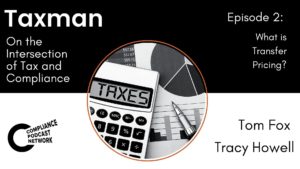What is the intersection of tax and compliance? Why does a Chief Compliance Officer (CCO) or compliance professional need to sit down with the corporate head of tax? How does a corporate tax function fit into a best practices compliance program? It turns out there is quite a bit a compliance professional can learn from a tax professional. Moreover, there are many aspects of tax which should be considered by a CCO and compliance professional from an overall risk management perspective. Unfortunately, these questions are rarely explored in the compliance community.
To explore these issues (and remedy this lack of awareness) I recently sat down with noted tax professional Tracy Howell to explore these and other questions. We tackled these issues and others in a five-part podcast series for Innovation in Compliance. In Part 2, we turn to the question of what is transfer pricing and what does this have to do with compliance?
We began at the beginning – what is transfer pricing and what methodologies are used to determine or estimate price transactions? Howell began with the rather astute obligation that if you are “a compliance officer and you can say anything more than just the words “transfer pricing”, you are indeed an FOT (Friend of Tax).” He went onto explain, “Transfer pricing encompasses the methodologies required by tax code and regulations around the world to price transactions between affiliated companies. It is the provision of and sale of goods between affiliates, sale of services, provision of services, including the licensing of intangibles. Finally, transfer pricing requires you to press the transactions at an arm’s length rate.”
Transfer pricing is a critical issue when you have transactions between related parties, which in a large multi-national organization is almost always. To help illustrate the issues involved, Howell compared two transactions. First if you are selling goods, “such as Ford Motor Company selling an automobile, it is easily comparable if manufactured in Canada and sold to the US, because you could compare that transaction to something that was manufactured by Chevrolet.” However, Howell noted, “when it gets really complicated is if you’re manufacturing proprietary products. In oilfield services for instance, your organization might manufacture a very unique valve. What would the arms-length rate be if it’s manufactured in the US and sold to Mexico?” Here the tax professional must have a process to prove the arms-length rate of value for sale between related parties. The methodology to do so would be to get some comparables for those kinds of transactions. But this may be hard to do if you are selling proprietary top specialized manufactured equipment.
As Howell related, “it becomes an art, and that art is developing and applying an arms-length rate for comparable transactions between comparable entities. Even trickier is if a one-off piece of equipment does not have a comparable, so then you have to broaden the scope of finding manufactured goods, for instance, or something comparable. It is an art and its normally tax issues of an exact nature and transfer pricing is not but the key is to have a defined methodology.”
We then turned to the several entities involved in the government side of transfer pricing and how they may at times be at odds, complicating the job of the tax professional as well as the compliance practitioner. Initially Howell noted that governments are involved with their different regimes for the selling and buying side of tax jurisdictions. This means in every case you have a seller of goods or services and a buyer. The objective of governments and their taxing jurisdictions is to get their fair share. In reality, this means that every government is trying to expand its tax base. They do that by trying to grab as much of multi-jurisdictional transactions profit as possible.
Then there are third party organizations that are involved, such as the Organization of Economic Cooperation and Development (OECD). The OECD is pushing standard transfer pricing laws and regulations throughout the world. They provide model laws, treaties and transfer pricing strategies. As Howell noted, their objective is to “try to standardize the government’s laws and regulations, so that you do not have a mismatch between very aggressive and very liberal transfer pricing laws. The OECD is trying to provide some guidance on what is a fair share.” But as Howell further related, “at the end of the day, what is fair? And that’s just somebody’s opinion; what is fair.”
We concluded with a look at the transfer pricing negotiation process. Most interestingly, the process Howell described mirrored the process when negotiating with the Department of Justice (DOJ) in a Foreign Corrupt Practices Act (FCPA) investigation or enforcement action. It all starts with your credibility. You must demonstrate credibility to the taxing authority and then back up that credibility with documentation (Document, Document, and Document). From there it is demonstrating your consistent process and methodology to demonstrate how you came up with a rate for transfer pricing of a good or service, similar to how a CCO would demonstrate compliance program effectiveness to the DOJ. But here the tax professional will face an added wrinkle from a that of a CCO. Howell explained that if you are in a country like Kazakhstan, your submission must in the format required by Kazakh law. If you are required to use local language in your submission, you are partway there. Howell ended with “you have not gone all the way. You must follow the laws, even if they are a little bit different. That includes language and formatting in all your jurisdictions.”
Join us tomorrow when we explain why tax needs a seat at the table. Check out the full podcast series Taxman: On the Intersection of Tax and Compliance on the Compliance Podcast Network. Check out Tracy Howell on LinkedIn.






